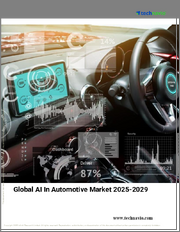
|
시장보고서
상품코드
1424188
성장 기회 : 자동차 업계의 2035년 동향Growth Opportunities: Future Trends in the Automotive Industry in 2035 |
||||||
기존 및 신기술, 동향, 이용 사례
세계 각국의 정부가 전기차를 인센티브로 전례 없는 양의 탄소 배출 감축을 시도하고 있는 가운데 수백만대의 화석 연료 자동차가 앞으로 수십년동안 도로를 계속 달리고 있다는 현실이 있습니다. 자동차 회사와 에너지 회사는 이를 염두에 두고 전기 연료 제조(재생 가능 에너지를 이용한 촉매 연료)에 대한 투자가 배출량 감축을 위한 유익한 방법이 될지 여부를 검토하고 있습니다. 일반적으로 eFuels라고 불리는 이러한 유형의 연료는 이미 사용 가능한 급유 인프라를 이용하여 기존 주유소에서 소비자에게 제공할 수 있습니다. 그러나 경제적인 역풍이 불고 기업이 신기술에 투자하는 능력과 소비자가 신기술을 구매하는 능력을 제한할 수 있습니다. 수소자동차와 eFuels는 여전히 비교적 새로운 기술이기 때문에 대규모 효율화에는 불리할 수 있습니다. Porsche는 시판 모델의 전기 자동차화를 이끌고 추진하고 있는 자동차 제조업체의 하나이며, 향후 10년간에 판매 대수의 80% 이상을 전기 자동차로할 것으로 예측했습니다.
본 조사에서는 업계 동향을 조사하고, 촉진요인과 억제요인을 고찰하고, 이해관계자에게 있어서의 성장 기회를 제시합니다.
목차
전략적 과제
- 왜 성장이 어려워지고 있는가?
- The Strategic Imperative 8(TM)
- 자동차 산업의 주요 전략적 과제의 영향
- Growth Pipeline Engine(TM)을 가속하는 성장 기회
성장 기회 분석
- 조사 범위와 정의/약어
- 성장 촉진요인
- 성장 억제요인
수소 연료전지 자동차의 현상과 2035년까지의 전망
- H2의 소망
- H2 : 세계 시선
- 미국 FCEV 판매 및 인프라: 현재와 예측
- 미국의 H2 전략
- FCEV 보급의 장벽을 해결하는 기술
AI 자동차 용도과 2035년까지의 전망
- 자동차의 밸류체인을 통한 AI
- 혁신적 AI 이용 사례: 연구 개발 및 원재료 조달
- 혁신적인 AI 이용 사례: 제조
- 혁신적인 AI 이용 사례: 판매 및 애프터마켓
- 혁신적인 AI 이용 사례: 비즈니스 운영
전동화에 따른 타이어 기술의 진화
- EV타이어
- 지속 가능한 타이어 구조
- 타이어의 미래 기술
저탄소 배출을 추구하는 도구, eFuels
- eFuels 개요 및 타임라인
- eFuels의 기술 개요
- 프로파일: Porsche
- eFuels의 미래
전기차 가격 설정(2023년과 2035년 비교)
- EV 가격 시장 : 2023년의 세계 전망
- 2023년 케이스: EV OEM간 가격 경쟁
- 왜 일어났는가?
- EV 가격 설정의 미래: 2035년의 세계 전망
서큘러 이코노미 : 지속 가능한 접근법
- 서큘러 이코노미 : 세계 전망
- 사례 연구: 서큘러 이코노미를 채용하는 OEM
- 2035년 로드맵: 서큘러 지속가능성
성장 기회
- 성장 기회 1: 대체 연료
- 성장 기회 2: 지속가능성 향상
- 성장 기회 3: 스마트/예측 기술
- 별지 리스트
- 면책사항
Existing and Emerging Technologies, Trends, and Use Cases
As governments around the world try to reduce carbon emissions by an unprecedent amount with electric vehicles as a focus of incentives, the reality is that millions fossil fuel-powered cars will remain on the road for decades to come. With this in mind, automotive and energy companies are considering whether an investment in electrofuel production (fuels catalyzed using renewable energy) would be a profitable way to reduce emissions. Fuels of this type, commonly known as eFuels, could be available to consumers at existing gas stations using already available fueling infrastructure. Still, economic headwinds appear to be developing that could restrict companies' ability to invest in new technologies and consumers' ability to purchase them. Hydrogen-powered vehicles and eFuels are still relatively new, which could put them at a disadvantage in gaining efficiency at scale. Porsche is one of the automakers taking the lead on introducing electric versions of its production models, projecting that in the next decade more than 80% of its sales will be EVs, and at the same time investing in eFuel production for higher-performance models.
This study explores developments in the industry, considers drivers and restraints, and presents growth opportunities for stakeholders.
Table of Contents
Strategic Imperatives
- Why Is It Increasingly Difficult to Grow?
- The Strategic Imperative 8™
- The Impact of the Top 3 Strategic Imperatives on the Automotive Industry
- Growth Opportunities Fuel the Growth Pipeline Engine™
Growth Opportunity Analysis
- Research Scope and Definitions/Acronyms
- Growth Drivers
- Growth Restraints
Hydrogen Fuel Cell Vehicle Current State and Outlook to 2035
- The H2 Rainbow
- H2: Global Glance
- US FCEV Sales and Infrastructure: Current and Projections
- US H2 Strategy
- Technology to Address Barriers to FCEV Adoption
AI Automotive Applications and Outlook to 2035
- AI Throughout the Auto Value Chain
- Innovative AI Use Cases: R&D and Raw Material Procurement
- Innovative AI Use Case: Manufacturing
- Innovative AI Use Cases: Sales and Aftermarket
- Innovative AI Use Case: Business Operations
The Evolution of Tire Technologies in the Context of Increased Electrification
- EV Tires
- Sustainable Tire Construction
- Future Technology in Tires
E-Fuels, a Tool in the Pursuit of Lower Carbon Emissions
- eFuels Overview & Timelines
- eFuels Technical Overview
- Profile: Porsche
- Future of eFuels
Electric Vehicle Pricing (2023 vs. 2035)
- The EV Pricing Market: A 2023 Global Outlook
- A 2023 Case: The Price War Between EV OEMs
- Why id the Take Place?
- Future of EV Pricing: A Global Outlook in 2035
Circular Economy: A Sustainable Approach
- Circular Economy: A Global Outlook
- Case Studies: OEMS Adopting a Circular Economy
- A Roadmap to 2035: Circular Sustainability
Growth Opportunity Universe
- Growth Opportunity 1: Fuel Alternatives
- Growth Opportunity 2: Increased Sustainability
- Growth Opportunity 3: Smarter/Predictive Tech
- List of Exhibits
- Legal Disclaimer



















